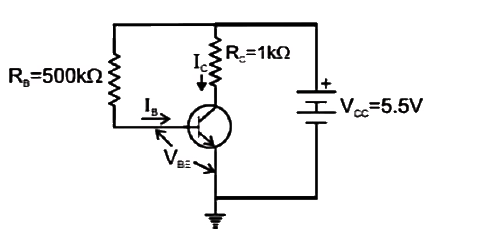In a single state transistor amplifier, when the signal changes by 0.02 V, the base current change by 10uA and collector current by 10μA. If collector load Rc=2kΩandRL=10kΩ, Calculate :
Input impedance,
To calculate the input impedance of a single state transistor amplifier, we can follow these steps:
Step 1: Understand the relationship between voltage, current, and impedance
The input impedance (Z_in) can be calculated using Ohm's law, which states that:
Z=VI
Where:
- V is the change in voltage (input signal)
- I is the change in base current
Step 2: Identify the given values
From the problem, we have:
- Change in voltage (ΔV) = 0.02 V
- Change in base current (ΔI_B) = 10 µA = 10×10−6 A
Step 3: Calculate the input impedance
Using the formula for input impedance:
Zin=ΔVΔIB
Substituting the values:
Zin=0.02V10×10−6A
Zin=0.0210×10−6
Zin=0.020.00001
Zin=2000Ω
Step 4: Conclusion
The input impedance of the transistor amplifier is:
Zin=2000Ω
---
The input impedance (Z_in) can be calculated using Ohm's law, which states that:
Z=VI
Where:
- V is the change in voltage (input signal)
- I is the change in base current
From the problem, we have:
- Change in voltage (ΔV) = 0.02 V
- Change in base current (ΔI_B) = 10 µA = 10×10−6 A
Using the formula for input impedance:
Zin=ΔVΔIB
Substituting the values:
Zin=0.02V10×10−6A
Zin=0.0210×10−6
Zin=0.020.00001
Zin=2000Ω
The input impedance of the transistor amplifier is:
Zin=2000Ω
Topper's Solved these Questions
- SEMICONDUCTOR DEVICESBOOK - AAKASH SERIESCHAPTER - SEMICONDUCTOR DEVICESEXERCISE - EXERCISE -I (ENERGY BANDS AND CLASSIFICATION OF SOLIDS )
41 Videos
- SEMICONDUCTOR DEVICESBOOK - AAKASH SERIESCHAPTER - SEMICONDUCTOR DEVICESEXERCISE - EXERCISE -I (P-N JUNCTION DIODE)
30 Videos
- SEMICONDUCTOR DEVICESBOOK - AAKASH SERIESCHAPTER - SEMICONDUCTOR DEVICESEXERCISE - Problems (LEVEL-II)
9 Videos
- RAY OPTICSBOOK - AAKASH SERIESCHAPTER - RAY OPTICSEXERCISE - PROBLEMS ( LEVEL-II)
60 Videos
- UNITS AND MEASUREMENTBOOK - AAKASH SERIESCHAPTER - UNITS AND MEASUREMENTEXERCISE - PRACTICE EXERCISE
45 Videos
Similar Questions
In a common emitter amplifier , when a signal of 40 mV is added to the input voltage, the base current changes by 100μA and emitter current changes by 2.1mA the trans-conductance is
View SolutionA transistor is used in CE mode in an amplifier circuit. When a signal of 40 mV is added to base-emitter voltage, the base current changes by 40μA and collector by 6mA. The load resistance is 10kΩ . Calculate
(i) The current gain β
(ii) The input resistance RBE
View Solution
Knowledge Check
In a common -emitter transistor amplifier, an increase of 50μA in the base current causes an increase of 1.0mA in the collector current . Calculat gain β. What will be the change in emitter current? Also calculate current gain α
A1050 mAB1050 μAC5025 mAD5025 μAThe input resistance of a transistor is 1000Ω on charging its base current by 10μA, the collector current increases by 2 mA. If a load resistance of 5kΩ is used in the circuit, the voltage gain of the amplifier is
A100B500C1000D1500
A transistor is used in common-emitter mode in an amplifier circuit. When a signal 20mV is added to the base-emmiter voltage,the base current changes by 20(μ)Aand the collector current changes by 2mA.The load resistance is 5k(Ω).Calculate (a)the factor(β)(b)the input resistance RBE,(c) the transconductance and (d) the voltage gain .
View SolutionIn a common emitter circuit, if VCE is changed by 0.2 V, then collector current changed by 4×10−3mA. Output resistance will be-
View SolutionA transistor is used in Common-emitter mode in an amplifier circuits. When a signal of 20 mV is added to the base-emitter voltage, the base current changes by 40μA and the collector current changes by 2mA. The load resistance is 5kΩ then the voltage gain is
View SolutionIn the circuit shown in figure,the base current IB is 10μA and the collector current is 5.2 mA . The voltage (VBE) across the base and emitter is

View SolutionFor a common emitter transistor amplifier, the audio signal voltage across the collector resistance (Rc) of 2kΩ is 2 V. If the current amplification factor (β) of the transistor is 100, calculate the input signal voltage (VBE) and base current (Ig) for base resistance of 1kΩ.
View SolutionIn a common emitter transistor transistor amplifier, the audio signal voltage across the collector is 3V. The resistance of collector is 3kΩ. If current gain is 100 and the base resistance is 2kΩ, the voltage and power gain of the amplifier are
View Solution
